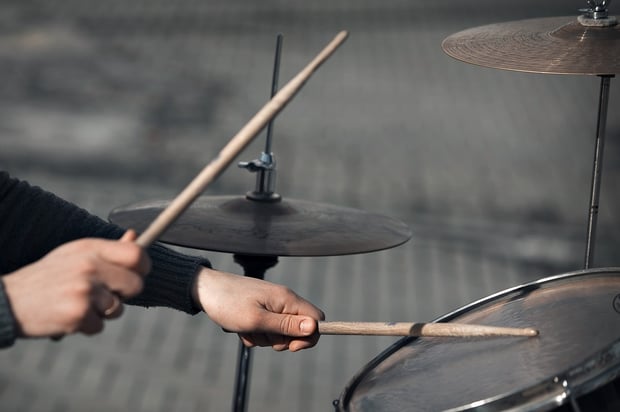 Image via Shutterstock
Image via Shutterstock
The perfect snare sound: nothing ties a good recording together quite like it. Snares can take on many different timbres, and different songs can demand very different snare sounds. As an engineer, there's a lot you can do in post-production to get the perfect snare sound for your mix. However, let's start by examining pre-production.
Pre-production
Before any microphones or recording technology comes into play, the sound you get from your snare is dependent about 10 percent on its wood, its size thickness, and kind, and about 90 percent on its drum head. A tighter drum head can result in a higher pitched, ringier sound that is also more responsive to the drummer's stick. The looser the head is, the fatter the sound will be. Another part of the snare to tighten or loosen is the snare wiring on the bottom of the drum, which can drastically affect the drum's timbre.
Many drummers use the addition of tape, cloth, or gels made specifically to dampen or "deaden" the snare to adjust their tone. This can be a desirable sound for many drummers, but don't overdo it. Snare ring is natural; that's what it was made to do. Experiment with these variables and try your best to get a take that sounds great. It'll make post-production a lot more fun.
Post-production
EQing
A snare's quality can be radically redefined, made to shine, or absolutely ruined during the EQing process. It takes a keen ear to hear where your snare should sit in the mix, meaning what frequency levels it should occupy to mesh best with the rest of the song. Here's a general guide to the frequency makeup of a common snare sound:
- Pulse, 200 Hz: Also sometimes referred to as the body, this is the lowest part of the snare, the part that really smacks you in the chest. The best place to get a good, clean pulse out of your snare drum is the 200–400 Hz area.
- Smack, 2 kHz: To give an idea of the smack of the snare, it's also referred to as the bang or the crack. Ideally, it should work closely with the pulse to make the snare sit well in the mix. Most of this sound is typically found around the 900 Hz–2.0 kHz range. When boosting the smack, a narrower bandwidth can be best to hone in on it without taking up too much space in a crowded mid-range.
- Wires, 5 kHz: This refers to the snare wires found on the bottom of the drum – the ones that set it far apart from any of the other drums on the kit. This characteristic buzz can be found at around 3–5 kHz in the EQ range. Be wary not to boost the wires too much, as this frequency can easily go wrong and get unpleasant. While boosting the wires isn't unheard of at all, the wires are often naturally accentuated to the point where you won’t have to boost them.
- Head, 7 kHz: Again, this range is exactly what it sounds like: the contact on the head of the drum, found in the 6–10 kHz range. You can add great texture to your snare sound by boosting this frequency using a peaking band or even a high-shelving band.
Compression
A light compression can be a great tool to use in post-production to even out the snare sound a bit and make it hit hard. However, depending on the quality of the performance you're working with, you may want to go easy on the compression. A good drummer will probably give a great performance on the snare full of dynamics and subtleties, and the last thing you want to do is squash it with too much compression. A healthy 4:1 ratio is a good starting point.
Reverb
Another very useful effect that can create a radically different sound from your drum is reverb. Explore your reverb options and add a little bit to see what works best. You may want to add a bright plate reverb or a small room sound, or maybe you have enough room in your sound already.
Above all else, you want to work together with your drummer to get the perfect sound. Explore the effects of all these techniques, and get a snare sound that gives your song exactly what it needs.
Max Monahan is a bassist and a writer living in Los Angeles. He spends his time working for an audio licensing website and shredding sweet bass riffs.







